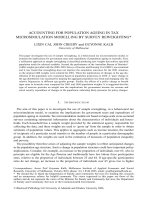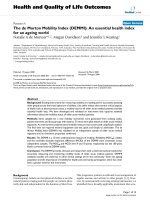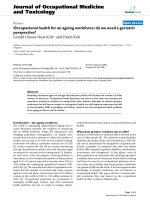Fit for purpose ageing cities
Bạn đang xem bản rút gọn của tài liệu. Xem và tải ngay bản đầy đủ của tài liệu tại đây (202.01 KB, 2 trang )
Ageing cities
What are cities doing to make urban environments more age-friendly?
M
ore than half the world’s population lives in cities, and by
2030 three out of five individuals will be urban dwellers. At the
same time, the share of the world’s population aged over 60 is
rising rapidly. By 2050 people aged over 65 will outnumber children
aged under 14, for the first time in human history. There is a growing
recognition that if the needs of older people are properly recognised,
this newly burgeoning population need not be a demographic
catastrophe. The elderly can continue to be an important resource for
families, communities and economies, but to make this happen, urban
environments need to be more age-friendly.
Eight years ago the World Health Organisation (WHO) launched an agefriendly cities project, based on responses to a survey of 1,500 older
people living in 33 cities in 22 countries. This in turn led to a guide with
a checklist of features that cities could use to assess their progress in
improving life for older residents. It included provisions for adapted
housing, employment, health services, transport, parks, social life and
information services, as well as a discussion of older people’s concerns
about how they are viewed and treated by their younger neighbours.
The European Commission’s Innovation Partnership on Active and
Healthy Ageing pilot scheme is making similar efforts to recognise
and benchmark age-friendly projects in the cities of member states.
These efforts include better urban planning, transport or housing
schemes and e-healthcare, allowing people to access medical help
and improving their opportunities for human contact, to prevent the
scourge of loneliness which besets many elderly people.
SPONSORED BY:
Around the world, any number of innovations are being tested.
Canada has come up with the notion of “pocket neighbourhoods” in
cities such as Toronto, with shared open spaces between families and
older neighbours to combat social isolation. Under the direction of
its recently formed Elderly Advisory Council, the city of Barcelona in
Spain has begun installing outdoor escalators to improve mobility and
access, and the Finnish capital Helsinki has tested robots in the form
of life-like baby harp seals responsive to touch and speech, which are
intended as virtual pets to reduce the burden on urban care agencies
looking after people with dementia. Chiayi City in Taiwan was among the
first cities in Asia to embrace age-friendliness. Its municipal authority
pioneered the concept of “health groceries”—neighbourhood centres
for older people offering a lunch club, healthcare talks and check-ups,
plus workshops and group activities.
It is in Asia that the impact of global ageing is being most keenly felt.
In 1950 there were 12 working-age people in Japan to support each
pensioner. By 2025 that ratio will be just two to one. In China the
one-child policy has caused a worsening crisis. Cities such as Beijing
and Tianjin have the world’s smallest populations of children, with
just 8% of residents aged under 14. In parallel, China has come up
with proposals for more “universities of the third age” for the active,
and more nursing homes for the frail, while South Korea has invested
heavily in part-time public-sector employment programmes for people
in their 70s, to stave off the multiple problems of poverty, loneliness
and ill health.
However, the city that is furthest ahead in terms of age-friendliness is
probably New York, the home of Ruth Finkelstein, director of the WHO
Collaborating Centre on Ageing, Globalisation and Urbanisation. Mrs
Finkelstein, who is also senior vice-president for policy and planning
at the New York Academy of Medicine, admits that earlier efforts to
cater for old people in segregated retirement areas were often not
appropriate. “The vast majority of people want to age where they
live, stay in their own homes and do what they like,” she says. “We
need to find out what the barriers are to them doing that and remove
them, because the more we have people of all ages involved in our
communities, the better it is for everyone.”
To ensure that this happens, the city has embarked on a variety of
measures in consultation with older residents. Many of the innovations
are simple. Hundreds of benches have been installed with sectioned
arm rests and space for shopping, so that frail elderly people have
somewhere to sit on their way out to buy food, without fear of being
unable to lift a carrier bag from the ground or rise to a standing
position. New transparent bus shelters including seats have been
sponsored by advertisers, so that older users feel safe and can sit down.
More than 1,000 corner shops have enjoyed a sales boost as a result of
applying for an “age-friendly” designation and receiving folding seats.
They also need to agree to offer regular glasses of water.
Lists of age-friendly swimming pools with ramp access and colleges
offering life-long learning opportunities have also been drawn up
to improve social opportunities. New York is about to announce the
winners of its first Age Smart Employer (ASE) awards, defined on the
basis of perks such as flexible working, training and professional
development for older people, and initiatives such as mutually
beneficial mentoring. This might include a younger employee teaching
an older one how to use new technologies, while older employees
might explain to younger colleagues how to offer personal service and
foster relationships with customers.
The ASE awards are being funded by the Alfred P. Sloan Foundation,
which was set up in 1934 by a former president of General Motors. Mr
Sloan, who lived in an era when assembly-line workers retired at 60 and
largely passed away soon afterwards, would no doubt be surprised to
find that life expectancy is now two or three decades longer, and even
more surprised to discover that people in their 70s are now actively
seeking the social and intellectual stimulation of continuing work.









